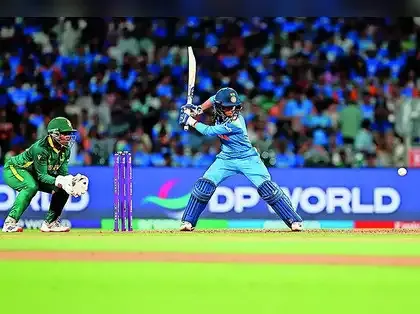India winning the ICC Women's World Cup has triggered much celebration. BCCI has undoubtedly played an important role in India's ascent in women's cricket by establishing best-in-class conditions for our female cricketers. One important decision being hailed is BCCI choosing to pay them on par with their male counterparts.
For any sport, a female player should have the capacity to earn the same as a male player at equivalent tournaments. They have each performed to the highest level in their sport. On this basis, differences in earnings are unjustifiable. But while pay parity by itself is laudable, paying India's women cricketers on par with men hides a larger issue. In a free market, pay must be linked with performance.
Like it or not, current viewership of women's cricket is far less than men's cricket. Even given the record viewership of the Women's World Cup, it still trailed the audience at Indian men's Asia Cup win in September, by a significant margin.
Or take the 2024 Women's Premier League (WPL) that drew record-breaking audiences and sponsorships. Yet, its media rights were valued at about ₹950 cr over 5 years - impressive, but 3% of IPL's ₹48,390 cr deal. Stadium attendance and TRPs have grown. But they're nowhere near parity.
No doubt BCCI's intent is noble. For decades, women athletes have played in the shadow of systemic bias, unequal opportunities and limited visibility. BCCI's decision corrects this and signals respect for performance, not gender. But when symbolic equality precedes economic logic, it risks creating an unsustainable model that can distort incentives, and slow natural growth of women's sport.
Pay parity in sports - and entertainment - sits at the intersection of economics, fairness, visibility and market dynamics. While parity is desirable, economic and market factors can't be disregarded.
All sports get money from gate sales, media rights and sponsorships. On all counts, women's sports attract less money. Paying women on par with men is politically correct, and appears egalitarian. But it's ruinous in the long run.
Take tennis. In 2024, men's world No. 1 Jannik Sinner raked in $19.7 mn in prize money. Women's No. 1 Aryna Sabalenka won less than half of that: $9.73 mn, in part reflecting the reality that men's tennis has a bigger following. This gets magnified in a sport like football.
Men's cricket still command higher ad rates, viewership and broadcast rights. Until the economics converge, total parity can strain smaller leagues or production houses. And even where parity exists, it risks being symbolic - a headline number that doesn't fix deeper inequities like unequal access to facilities, limited roles or lower marketing budgets for women's projects.
While BCCI can afford it from its larger surplus, the economics actually don't permit it. It's robbing Peter to pay Paul, or in this case, robbing Peter to pay Mary.
If compensation is divorced from commercial performance, sports bodies risk creating an economic imbalance where revenues from the men's game effectively subsidise the women's. That may be viable for a short period. But, over time, it can lead to resentment among stakeholders and financial trouble for federations.
Distributing surpluses is easy and builds statesmen-like reputations. But imagine the plight of other sporting associations like hockey, kabaddi, volleyball and football, when female sportspersons demand equal pay. Enforced parity could hurt smaller associations and sports will suffer.
A flat pay parity rule won't fix deeper inequities like lack of promotion, fewer professional tournaments, or unequal access to facilities and agents. Forcing parity too early can also blur incentives. When pay is guaranteed at the top without equivalent fan engagement or competition depth below, federations may feel less pressure to invest in grassroots development, infrastructure and marketing - real drivers of long-term equality.
True equity isn't about matching pay slips. It's about matching opportunities. Without parallel investment in coaching, scouting, facilities and broadcasting for women's sports, the field remains uneven - regardless of match fees.
There's also the danger of tokenism. When equal pay becomes a headline achievement rather than part of broader reform, it can divert attention from structural investments women's sports desperately need.
The real solution lies not just in equal pay but in equal opportunity. That means equal investment in women's leagues, training academies and women-centric sports projects. It means transparent, performance-based contracts, where pay reflects measurable contribution, not gender assumptions.
When women's cricket achieves audience and revenue parity - and it's heading there fast - equal pay will not be a moral victory; it will be a market reality.
For any sport, a female player should have the capacity to earn the same as a male player at equivalent tournaments. They have each performed to the highest level in their sport. On this basis, differences in earnings are unjustifiable. But while pay parity by itself is laudable, paying India's women cricketers on par with men hides a larger issue. In a free market, pay must be linked with performance.
Like it or not, current viewership of women's cricket is far less than men's cricket. Even given the record viewership of the Women's World Cup, it still trailed the audience at Indian men's Asia Cup win in September, by a significant margin.
Or take the 2024 Women's Premier League (WPL) that drew record-breaking audiences and sponsorships. Yet, its media rights were valued at about ₹950 cr over 5 years - impressive, but 3% of IPL's ₹48,390 cr deal. Stadium attendance and TRPs have grown. But they're nowhere near parity.
No doubt BCCI's intent is noble. For decades, women athletes have played in the shadow of systemic bias, unequal opportunities and limited visibility. BCCI's decision corrects this and signals respect for performance, not gender. But when symbolic equality precedes economic logic, it risks creating an unsustainable model that can distort incentives, and slow natural growth of women's sport.
Pay parity in sports - and entertainment - sits at the intersection of economics, fairness, visibility and market dynamics. While parity is desirable, economic and market factors can't be disregarded.
All sports get money from gate sales, media rights and sponsorships. On all counts, women's sports attract less money. Paying women on par with men is politically correct, and appears egalitarian. But it's ruinous in the long run.
Take tennis. In 2024, men's world No. 1 Jannik Sinner raked in $19.7 mn in prize money. Women's No. 1 Aryna Sabalenka won less than half of that: $9.73 mn, in part reflecting the reality that men's tennis has a bigger following. This gets magnified in a sport like football.
Men's cricket still command higher ad rates, viewership and broadcast rights. Until the economics converge, total parity can strain smaller leagues or production houses. And even where parity exists, it risks being symbolic - a headline number that doesn't fix deeper inequities like unequal access to facilities, limited roles or lower marketing budgets for women's projects.
While BCCI can afford it from its larger surplus, the economics actually don't permit it. It's robbing Peter to pay Paul, or in this case, robbing Peter to pay Mary.
If compensation is divorced from commercial performance, sports bodies risk creating an economic imbalance where revenues from the men's game effectively subsidise the women's. That may be viable for a short period. But, over time, it can lead to resentment among stakeholders and financial trouble for federations.
Distributing surpluses is easy and builds statesmen-like reputations. But imagine the plight of other sporting associations like hockey, kabaddi, volleyball and football, when female sportspersons demand equal pay. Enforced parity could hurt smaller associations and sports will suffer.
A flat pay parity rule won't fix deeper inequities like lack of promotion, fewer professional tournaments, or unequal access to facilities and agents. Forcing parity too early can also blur incentives. When pay is guaranteed at the top without equivalent fan engagement or competition depth below, federations may feel less pressure to invest in grassroots development, infrastructure and marketing - real drivers of long-term equality.
True equity isn't about matching pay slips. It's about matching opportunities. Without parallel investment in coaching, scouting, facilities and broadcasting for women's sports, the field remains uneven - regardless of match fees.
There's also the danger of tokenism. When equal pay becomes a headline achievement rather than part of broader reform, it can divert attention from structural investments women's sports desperately need.
The real solution lies not just in equal pay but in equal opportunity. That means equal investment in women's leagues, training academies and women-centric sports projects. It means transparent, performance-based contracts, where pay reflects measurable contribution, not gender assumptions.
When women's cricket achieves audience and revenue parity - and it's heading there fast - equal pay will not be a moral victory; it will be a market reality.
(Disclaimer: The opinions expressed in this column are that of the writer. The facts and opinions expressed here do not reflect the views of www.economictimes.com.)









Lloyd Mathias
The writer is former marketer at PepsiCo